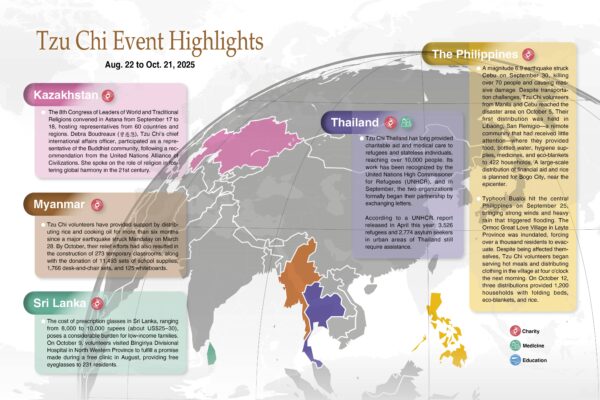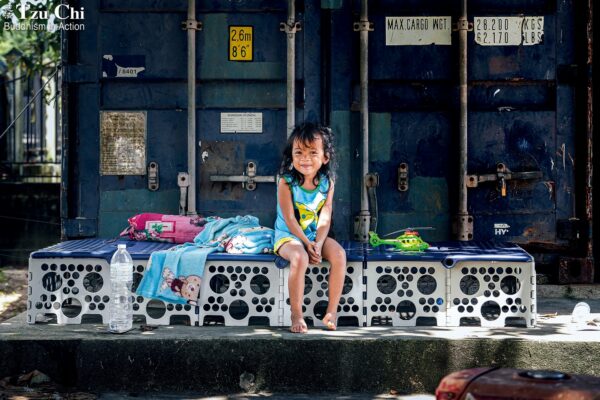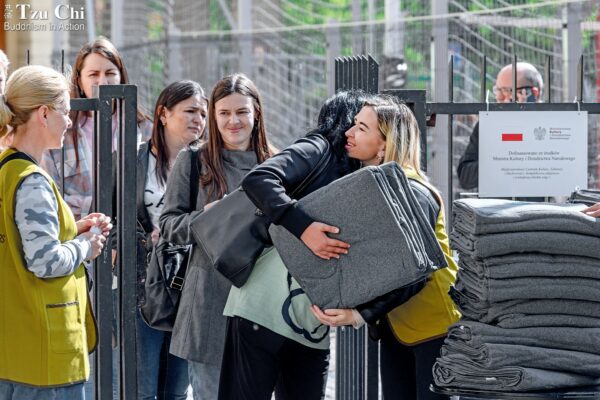By Yeh Tzu-hao
Translated by Wu Hsiao-ting
Photo by Hsiao Yiu-hwa
Denim, a durable cloth often used to make jeans, is one of the most resource-intensive materials in fashion. A young fashion designer is giving recycled denim a new lease of life to help reduce its environmental cost.
Zhan Ming-zhu (詹明珠), in her sixties, can operate a sewing machine with deftness, assembling pieces of fabric into a garment with skill and ease. She has difficulty getting around due to the aftereffects of polio, but she was endowed with the gift of good workmanship. This has enabled her to supplement her family’s income ever since she was young by sewing clothes for others. After she joined Tzu Chi, she applied her talent to teaching her fellow volunteers how to make reusable shopping bags from recycled fabric. A major part of her life has been spent amidst needles, threads, fabrics, and scissors.
Three years ago, Zhan learned from a Da Ai TV program about a social enterprise founded by a young fashion designer named Kuan Chen (陳冠百). Out of curiosity, she visited Chen’s workshop on Dihua Street, Taipei, northern Taiwan, for a look. That eventually led to her working there.
“I put together pieces of cloth at the workshop,” explained Zhan. “Every garment we make is unique.” Assembling segments of cloth into garments is fun for her. She especially appreciates still being able to put her sewing skills to good use in a world dominated by machine-made clothes and where handmade tailoring has long been in decline. It’s no surprise, therefore, that she is full of gratitude when she speaks of her employer, Kuan Chen, who is about the same age as her daughter. Zhan is quick to express her admiration for her, too. “After all, it’s not easy for a young person to start a business.”
Kuan Chen’s hectic schedule testifies to the work she does as an entrepreneur. “Sorry, I’ll be ten minutes late,” she texted to a reporter. “I’m just getting off the train.” Though she had taken an earlier train to be on time for the interview, she was running a bit behind. She was returning from Kaohsiung, southern Taiwan, to Taipei, after participating in an exhibition the day before in the southern port city.
Chen has led a busy life since she founded Story Wear, a sustainable fashion brand, in 2018. Her time has been divided between attending exhibitions, both in Taiwan and abroad; visiting textile companies, public service groups, or recycling stations; and taking care of everything else related to running her business. What makes her brand stand out is that it transforms recycled denim into fashionable wear while creating work opportunities for disadvantaged women and senior seamstresses looking for employment. The combination of a social enterprise and sustainable fashion makes Story Wear a story worth telling.
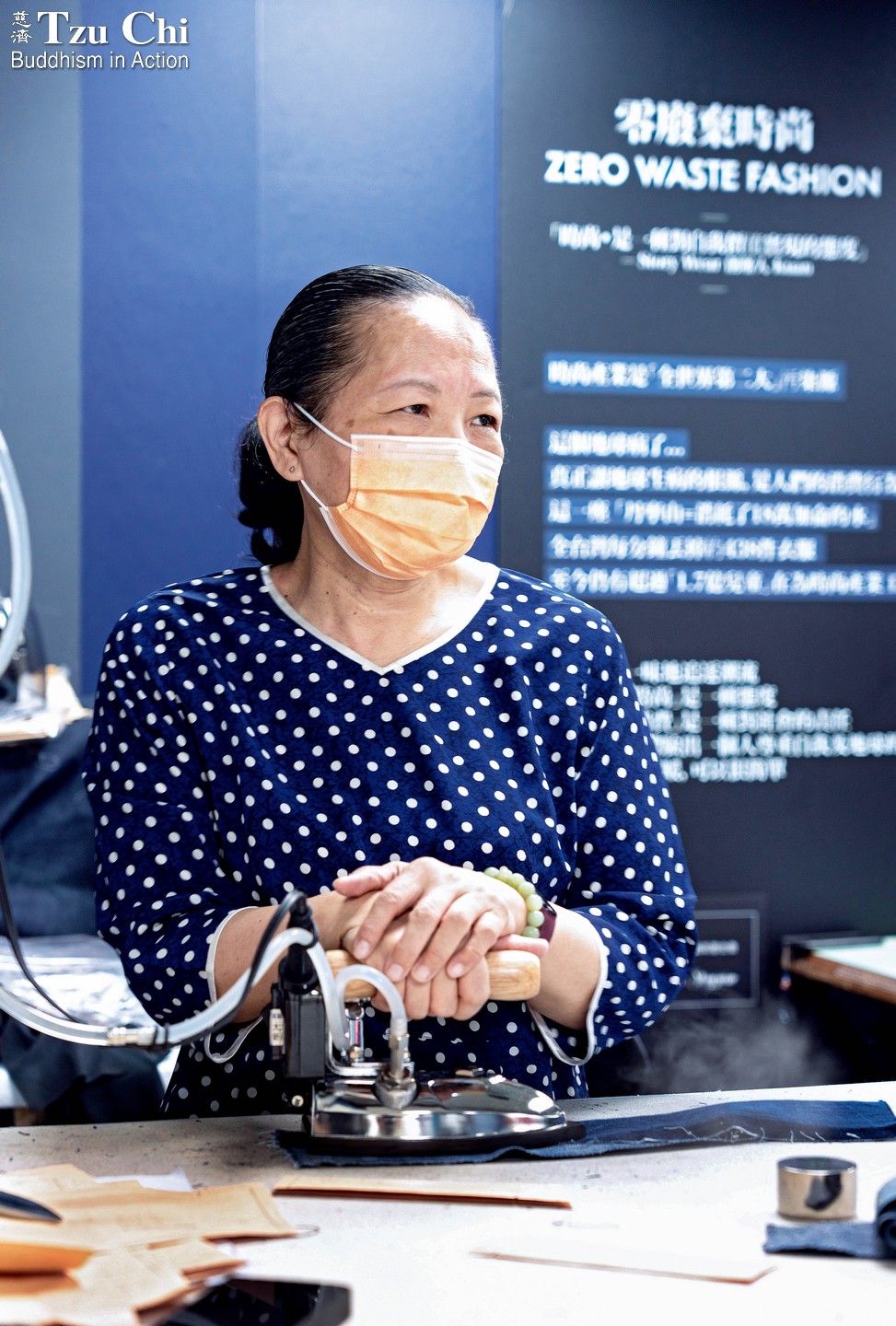
Zhan Ming-zhu, over 60, joined Story Wear, a sustainable fashion brand, to put her sewing skills to good use by transforming recycled denim fabrics into new clothes.
In the name of the environment
“Our clothes are generally thicker, and the weather is very warm in Kaohsiung, but the sale of our clothes [at the exhibition] was still very brisk,” said Chen about the event she had participated in the day before. Her joy was palpable as she recounted the enthusiastic response her brand had received at the port city. She said that each article of clothing produced by Story Wear has a label on it that bears the handwritten signature of the seamstress who made the garment. It also includes the number of hours taken to make it. “People who buy our clothing find that touching,” Chen observed.
Chen first learned about the concept of sustainable fashion when she went to the UK in 2013 to pursue a master’s degree in fashion management. It was during her time in that country that she came to realize the various problems caused by fast fashion. “The textile and clothing industry is the world’s second largest polluter,” she said, “accounting for 20 percent of marine pollution. There are other issues as well, such as the use of child labor in cotton cultivation and the highly polluted work environments faced by workers in the industry.”
Inflation has caused everything to go up in price, but a T-shirt sells for a lower price than it did 20 years ago. Operating on the basis of mass production and low cost, fast fashion’s “low-margin, high-volume” business model has come at the expense of people and the environment. What’s more, overconsumption of fast fashion is resulting in a large amount of waste, making the disposal of used clothes a headache for countries around the world.
The crux of the problem, Chen pointed out, is that too much has and is being produced. “If we add up all the fast fashion items of clothing produced in a year,” she said, “the number might be as large as the world population. The ultimate way to solve the problem is to get consumers to buy less and opt for better quality. This is the only way that will cause manufacturers to produce less.”
In response to the fast fashion phenomenon, demands have been placed on companies in the industry to meet their social responsibility. As a result, some fast fashion brands have urged their supply chains to protect their workers’ rights and cut back on pollution. Some have even begun to use materials obtained from recycled PET bottles to make apparel. Environmentally conscious consumers have also taken action to buck the fast fashion trend, leading to the popularity of secondhand clothes stores and rent-instead-of-buy services. This has made sustainable fashion a noticeable trend in Europe and the United States. “The fashion industry is hoping to achieve net zero emissions by 2050,” said Chen. “The global market is now very supportive of sustainable fashion. This might be a very good opportunity for Taiwan.”
Things weren’t as promising five years ago, when Chen first decided to establish Story Wear. Back then, an attitude of responsible consumption when it came to clothing hadn’t yet emerged in Taiwan. There was a surplus of used clothes, a problem exacerbated by the difficulty faced by recycling dealers in finding buyers from abroad. Even public welfare organizations were overwhelmed with donated clothes that had nowhere to go.
Chen did some on-site research work and found that among the secondhand clothes discarded or donated by people, those made from cotton comprised the largest percentage, especially cotton T-shirts. However, because the materials used to make such items were usually soft and thin, they weren’t suitable to be cut up and remade into new apparel. Even converting them back into raw textile materials would be difficult. Denim jeans, also made from cotton, were a different story though. Their characteristics made them ideal for being remanufactured into new garments.
“Denim fabrics are tough and durable, and they don’t go out of fashion,” said Chen. “After being recycled and remade into new clothes, they can still be worn a long time. Even if they fade in color, they still look trendy.”
Denim jeans were invented in the 19th century for the Gold Rush miners in the American West who needed sturdy, durable clothing. Because of their toughness and durability, they later became popular with cowboys. After World War II, the image of American cowboys clad in jeans spread across the world via Hollywood movies. This type of attire was therefore dubbed “cowboy pants” among Chinese-speaking populations. Chen’s first Story Wear garment was made from such “cowboy pants” and part of a suit belonging to her late father, Chen Xiao-qing (陳曉慶).
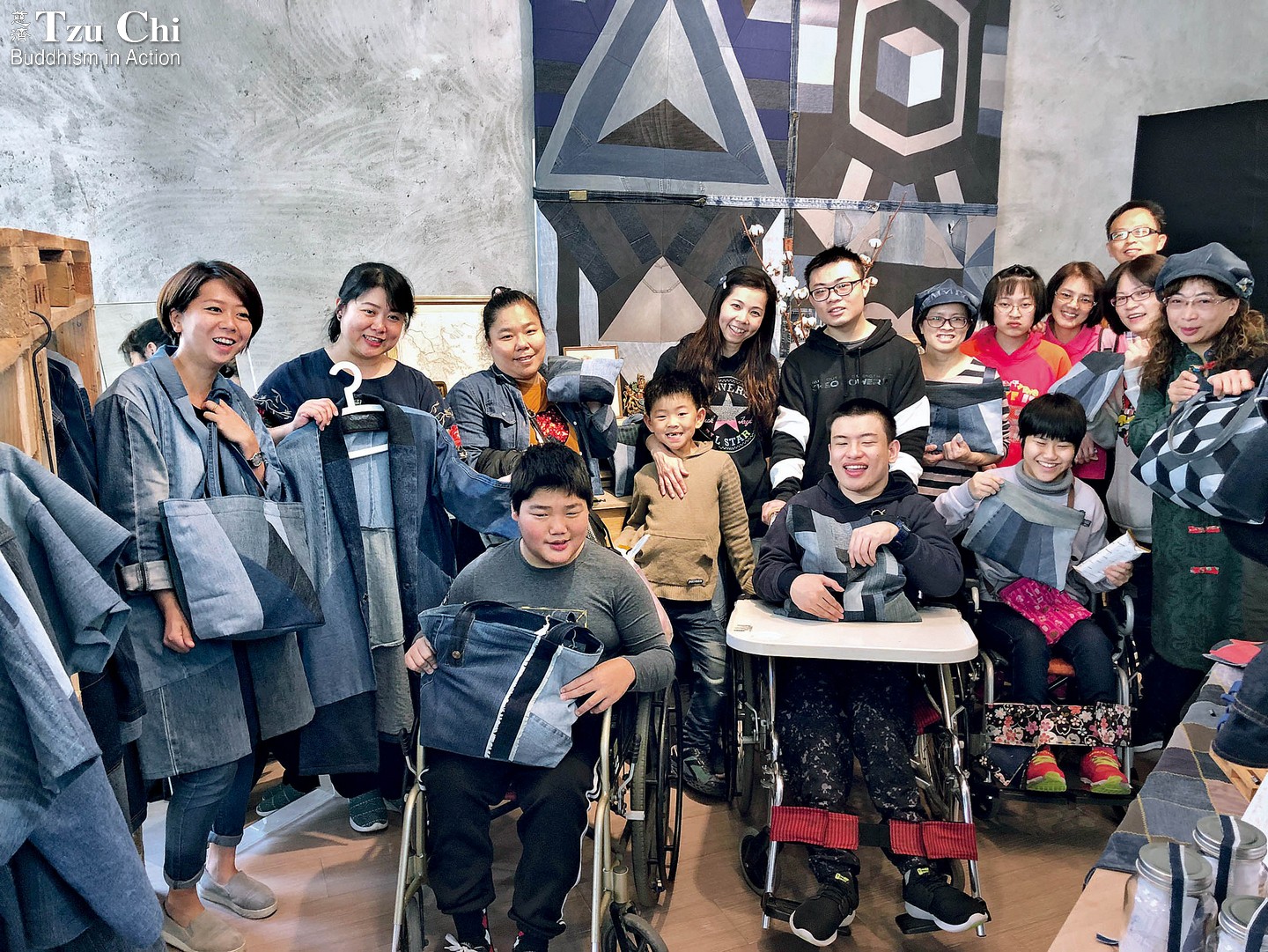
Kuan Chen (left) started a social enterprise based on the ideal of sustainable fashion. She encourages mothers with children afflicted with cerebral palsy to work for her brand as a way to join the workforce. Courtesy of Kuan Chen
Denim is actually one of the most resource-intensive, environmentally damaging materials in fashion. It is made from cotton, the production of which requires a lot of water: more than 8,500 liters (2,245 gallons) per kilogram (2.2 pounds). That, coupled with the chemicals required in the dyeing process, the wastewater that results, and the carbon footprint of its transportation, easily makes the environmental cost of jeans hundreds or thousands of times what they are sold for on the market. It’s therefore best for the environment if denim is recycled and reused.
Aside from helping the environment, Chen hopes to help take care of the disadvantaged and revive the art of seamstressing via her social enterprise too. To that end, she has joined hands with the Awakening Foundation, the Cerebral Palsy Association, and other public service organizations. She’s also invited retired seamstresses to teach disadvantaged women tailoring skills so that they can become independent or help support their families.
“More than ten seamstresses are working with us to pass on their skills,” Chen explained. “They are all very willing to travel to different places to share their expertise with the women we are trying to help.”
Chen receives the materials used to make Story Wear garments from individual donors as well as textile companies, which provide sample fabrics and unsold inventories. Tzu Chi is also an important source.
“A customer once asked me, ‘Since your materials are mostly donated, why do you still charge so much for your products?’” Chen said. Indeed, Story Wear clothing is sold at prices not easily affordable by everyone. She went on to explain why. “It’s because our production process is time-consuming and labor-intensive. For example, it might take 20 to 30 minutes to dissemble a pair of jeans, though an experienced seamstress might be able to cut that time down to ten to 15 minutes.” Chen also insists on paying all designers and seamstresses a reasonable wage, which is reflected in the prices of her apparel.
She emphasizes that what motivated her to start her business was not to make as much money as she could, but to add a warm, human element to the fashion industry and to inspire people to shop consciously and cherish the clothes they buy. “Buy less and better,” she says. She believes that only by getting people to change their overconsumption habits is it possible to reverse the fast fashion trend and tackle the pollution problem caused by the industry at its root.
Her efforts to contribute to sustainable fashion have won recognition. In 2020, she was chosen by Tzu Chi to participate in a sponsorship program for young people with good ideas to better the world. Her story might inspire us to think about what we, as end consumers, can do the next time we are tempted to buy yet another piece of clothing.

